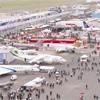Bankers worse than swine flu, exec says
Bloomberg

refid:11904202 ilişkili resim dosyası
The biggest threat to the global airline industry isn’t the swine flu outbreak, according to AirAsia Bhd.’s Tony Fernandes."We’ve been through SARS, bird flu, tsunami, you name it," Fernandes, the founder and chief executive officer of Southeast Asia’s biggest discount carrier, said at the Paris Air Show. "The only swine now are bankers."
Carriers, already coping with a slump in travel, also have to deal with banks that are unwilling to finance aircraft purchases. Airlines have to come up with money to pay for jets ordered years ago or face penalties for cancellations. In 2010, the funding shortfall may reach $36 billion, or as much as 60 percent of the spending on larger aircraft, said Nick Cunningham, an analyst at Evolution Securities in London.
Chasing debt
"Debt is the critical component of any strategy right now," said Steve Rimmer, CEO of Guggenheim Aviation Partners. Guggenheim has 56 aircraft either owned or under contract with a value of $2.5 billion and makes money by leasing them to carriers in return for regular payments. "We, like everyone, are chasing debt."
Airlines, which posted a total of $10.4 billion in losses in 2008 according to the International Air Transport Association, are eliminating jobs, cutting routes and grounding planes to survive a slowdown.
AirAsia X, the long-haul affiliate of Malaysia-based AirAsia Bhd., is seeking short-term financing from more banks and paying higher borrowing costs, said Azran Osman Rani, the CEO of AirAsia X. The airline announced an order the Paris show for 10 Airbus SAS A350s, valued at $2.4 billion at list prices, as regional low-cost traffic grows in defiance of the global aviation slump.
AirAsia said its borrowing costs have climbed less than 1 percentage point from a year earlier. Air France-KLM, Europe’s biggest airline, said the cost of financing aircraft purchases has increased by about 2.2 percentage points from a year ago.
"A year ago, when you wanted to finance an aircraft you’d have a queue through your doors," Air France CEO Pierre-Henri Gourgeon said in an interview last month. "Once when we asked for three aircraft to be financed we got positive answers from 12 banks. Now it’s the reverse. It takes a lot of time."
Paris-based Air France has turned to BOC Aviation, Asia’s biggest aircraft lessor and a unit of Bank of China, to help finance jetliner purchases. Air France’s traditional lenders include Calyon Securities and Natixis Transport Finance, a unit of Natixis, both based in Paris.
BOC Aviation said on June 4 that it will borrow as much as $560 million to help finance aircraft purchases. The Singapore-based company has acquired 40 planes since December and predicts it will have invested $10 billion in jets by 2012, more than doubling the current fleet size of 96.
The backing of Bank of China, the nation’s third-largest bank by assets, gives BOC an advantage amid financial woes at General Electric, whose Gecas aircraft-leasing unit has the biggest fleet in the world, and American International Group, the owner of International Lease Finance Corp., said Alasdair Whyte, the publisher of Airfinance Journal.
"BOC has been one of the few lessors who’ve had a parent willing to support them," Whyte said. "There’s a complete shortage on the lessor scene for sale-leasebacks."
GE says it’s coming back into the market now that capital markets have eased.
"We, in recent months, have seen our funding costs decline significantly," said Norm Liu, who becomes Gecas’s chief starting next month. "It’s the down cycle, and that’s typically the best time to invest."
That’s what John Slattery is doing. The former head of Royal Bank of Scotland Group’s RBS Aviation Capital founded GreenStone Aviation in Dublin last week, after amassing $100 million from Jefferies Capital Partners, to do only jetliner sale-leaseback transactions. Slattery said he wants to attract as much as $500 million in private equity funding by the end of next year.
The difference between the value of an aircraft during an economic boom and a recession is typically 12 percent to 15 percent, Slattery said. In the current cycle, worsened by the credit crunch, the gap could be as much as 20 percent, he said. In addition to receiving monthly leasing payments, aircraft lessors retain the planes for possible sale later.
Airplane makers jump in only as a last resort when their customers can’t get financing elsewhere. "We’re not a bank, not a charity organization," Airbus CEO Tom Enders said last week during the biennial show, the largest for the aerospace industry. "We have to use funds on a very selected basis."
















